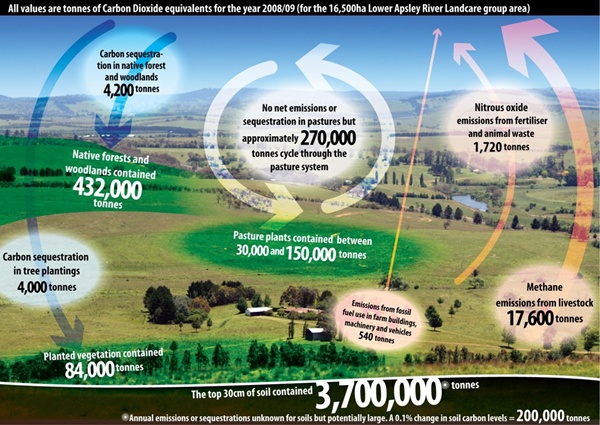Carbon rules make sequestration hard to track
-----------------
FARMERS are managing an enormous amount of carbon in their landscapes, but get very little credit for the fact under the current Kyoto greenhouse gas accounting rules.
That was the finding of a study by the Lower Apsley Landcare Group in the southern New England, which attempted to quantify carbon flows and sinks across the 16,500 hectares managed by the 20 farmers in the group’s catchment.
The study found the farmers were collectively managing as much as 4.36 million tonnes of carbon dioxide equivalents (CO2-e), while emitting about 20,000t of CO2-e per year into the atmosphere.
Under current accounting rules, virtually none of the carbon in the landscape - and very little of that cycled into the landscape from the atmosphere - is counted as an asset, while virtually all the emissions are counted as a liability. 
Lower Apsley won the 2007 State Landcare Award, and decided to invest the $10,000 winner’s cheque donated by Qantas towards a study that assessed all the carbon under management by the group.
Shane Andrews of the Northern Inland Forestry Investment Group took up the challenge of doing a landscape-scale study on a very tight budget.
Mr Andrews told a forum in Walcha on Monday that with considerable hands-on assistance from farmers like Lower Apsley chairman Ross King of Waterloo Station - who also convened the forum - he was able to do enough on-ground sampling to piece together the greenhouse gas jigsaw in a way that provided a degree of scientific rigour.
He established that the amount of carbon held in the Lower Apsley landscape was substantial.
Most of it - 3.7 million tonnes, in Mr Andrews’s estimation - was in the top 30cm of soil. The remainder was shared between native woodlands, planted woodlands and pastures.
The Lower Apsley pastures neither sequestered or emitted carbon, Mr Andrews suggested, but each year about 270,000t of CO2-e cycled through them.
Fast-growing planted woodlands - one of the reasons Lower Apsley won a Landcare award - sequestered about 4000t of CO2-e per year, and mature native woodlands sequestered about 4200t of CO2-e per year.
However, under Kyoto accounting rules only plantings since 1990 were counted. Just attempting to prove that criteria could be an administrative nightmare, Mr Andrews said.
When it came to soil sequestration, potentially the biggest source of greenhouse gas sequestration, Mr Andrews gave up. Quantifying sequestration rates across a range of soil types and vegetation covers proved impossible. 
“The problem with soils is that we can work with big changes in the levels of soil carbon, but we can’t measure small changes,” Mr Andrews told the forum.
“Lifting soil carbon levels by 0.1 per cent across the Lower Apsley would sequester an extra 200,000t of CO2-e a year - but we can’t measure a change that small.”
On the debit side, livestock methane, nitrous oxide emissions from fertiliser and urine, and emissions from buildings and vehicles gave the 20 farmers a combined greenhouse gas liability of just under 20,000t of CO2-e.
The nub of the study, Mr Andrews said, was that all this liability could be easily measured, but sequestration - particularly in soils - could not.
That would be an issue for any emissions trading scheme that involved agriculture, he suggested.
Professor Annette Cowie, director of the National Centre for Greenhouse Gas Research, welcomed the Lower Apsley study as a necessary step toward a better understanding of greenhouse gas life cycles in agriculture.
“If there is a system that requires landholders to stump up for their emissions, then there is a need for a system to manage the sequestration side of accounts too,” Professor Cowie said.
She added there was growing international recognition that the way methane was converted into carbon dioxide equivalents may not be an accurate reflection of the gas’s role in global warming.
Work was now in progress to assess whether a new methane standard was needed.
---------------

